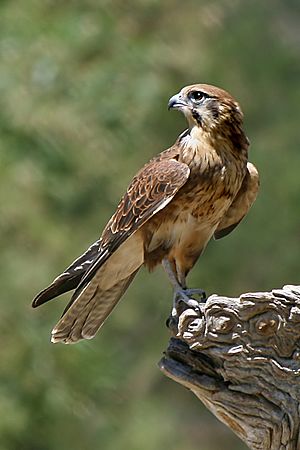Falconiformes facts for kids
Quick facts for kids Falconiformes |
|
|---|---|
 |
|
| Brown falcon (Falco berigora) | |
| Scientific classification | |
| Kingdom: | |
| Phylum: | |
| Class: | |
| Order: |
Falconiformes
Sharpe, 1874
|
| Family: | |
The order Falconiformes is a group of about 290 types of birds. These birds are known as "diurnal birds of prey," which means they hunt and are active mostly during the day, especially around dawn and dusk. All Falconiformes birds have babies that stay in the nest for a while after hatching. Both parent birds take care of their young until they are ready to leave the nest.
Contents
What are Falconiformes?
Falconiformes are powerful birds that are excellent hunters. They have sharp beaks, strong claws called talons, and amazing eyesight. These features help them catch their food, which usually includes small mammals, other birds, and insects.
Types of Falconiformes
The main family within the Falconiformes order is Falconidae, which includes all the different types of falcons. These birds are known for their speed and agility in the air.
Falcons: Masters of Flight
Falcons are famous for being some of the fastest birds in the world. For example, the Peregrine Falcon can dive at speeds over 200 miles per hour (320 kilometers per hour) when hunting! They have long, pointed wings that help them fly very quickly and change direction easily.
- Size: Falcons come in many sizes, from small ones like the Kestrel to larger ones like the Gyrfalcon.
- Hunting Style: They often hunt by flying high above their prey and then diving down very fast to catch it.
- Beaks and Talons: Their beaks are strong and hooked, perfect for tearing meat. Their talons are sharp and powerful, used for grabbing and holding onto their prey.
Where do Falconiformes Live?
You can find Falconiformes birds all over the world, except for Antarctica. They live in many different places, from forests and grasslands to deserts and even cities. They adapt well to various environments as long as there's enough food for them to hunt.
Habitats of Falcons
Different species of falcons prefer different types of homes:
- Open Areas: Many falcons, like the Peregrine Falcon, prefer open spaces where they can see their prey from far away. This includes coastlines, cliffs, and open fields.
- Forests: Some falcons, like the Forest Falcon, live in wooded areas, where they hunt among the trees.
- Urban Areas: Surprisingly, some falcons have adapted to living in cities, often nesting on tall buildings that act like cliffs.
Life Cycle of Falconiformes
Falconiformes birds usually build their nests in high places, like on cliffs, in tall trees, or sometimes even on human-made structures. Both parents work together to raise their young.
Nesting and Eggs
Female falcons typically lay a few eggs, which are often speckled or spotted. Both the male and female take turns sitting on the eggs to keep them warm until they hatch. This period is called incubation.
Raising the Chicks
Once the eggs hatch, the baby birds, called chicks, are very helpless. They are covered in soft down feathers. The parents bring food back to the nest for the chicks. As the chicks grow, they develop their flight feathers and learn to hunt from their parents. Eventually, they leave the nest and become independent.
Importance in Ecosystems
Falconiformes play a very important role in their ecosystems. As predators, they help control the populations of small animals. This keeps the environment healthy and balanced. For example, by eating rodents, they help prevent too many of these animals from damaging crops or spreading diseases.
See also
 In Spanish: Falconiformes para niños
In Spanish: Falconiformes para niños

